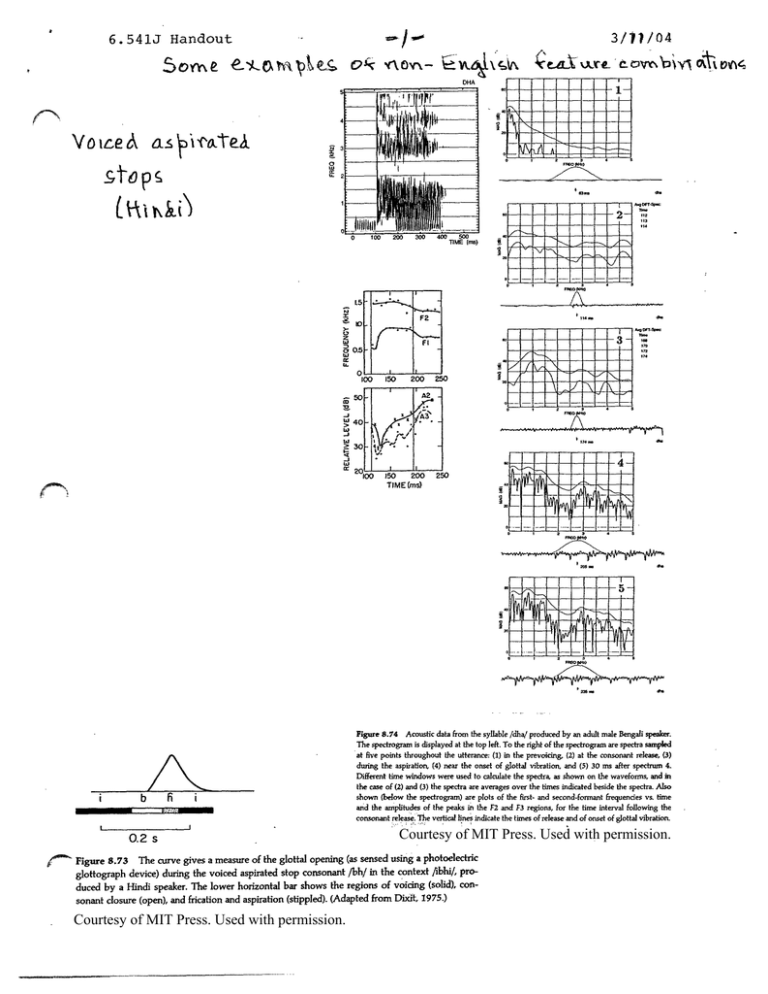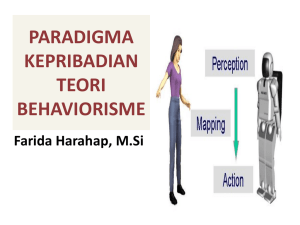I t- -- >- - -
advertisement

--
6.541J Handout
3/11/04
-/
6.i
Y
ok
Ckxahmpbae~
S0ynzp-e
OVrt P
Ce.AUx
vdHA
%-
DHA
VoeA as i'oteA
cT
_
I
_
1--
I.
e If-
t--- >-- -
L.0]+81#1
S
lW
o- 2M--L
4
3
I
- fS
v
stop .
2
Sin
( hiai
500
naFM
I... -... (mn
,
-30 Lt5
2
52
100
b
I
150
200
TIME (ms)
250
Figure 8.74 Acoustic data from the syllable /dha/ produced by an adult male Bengali speaker.
The spectrogram is displayed at the top left. To the right of the spectrogram are spectra sampled
at five points throughout the utterance: (1) in the prevoicing, (2) at the consonant release, (3)
during the aspiration, (4) near the onset of glottal vibration, and (5) 30 ms after spectrum 4.
Different time windows were used to calculate the spectra, as shown on the waveforms. and in
the case of (2) and (3) the spectra are averages over the times indicated beside the spectra. Also
shown (below the spectrogram) are plots of the first- and second-formant frequencies vs. time
and the amplitudes of the peaks in the F2 and F3 regions, for the time interval following the
vertical lines indicate the times of release and of onset of glottal vibration
consonant release. -The
-I
fi
?-i . !
DI
,
Courtesy of MIT Press. Used with permission.
0.2 s
' Figure 8.73 The curve gives a measure of the glottal opening (as sensed using a photoelectric
glottograph device) during the voiced aspirated stop consonant /bh/ in the context fibhi/, produced by a Hindi speaker. The lower horizontal bar shows the regions of voicing (solid), consonant closure (open), and frication and aspiration (stippled). (Adapted from Dixit, 1975.)
Courtesy of MIT Press. Used with permission.
--------
�-
rY4
OcYV
Courtesy of MIT Press. Used with permission.
Courtesy of MIT Press. Used with permission.
Tones On Single Vowels
A
Arc
ne
,'
{T
Tones (Thai)
Frequency in CPS
140
c,
a
130
0
z
z
120
w
aL
LL.
110
100
90
DURATION
0FIG. 3.5 TONES ON 50SINGLE VOWELS 100%
Duration
muttu
7
6 P
-5
annh
aplra\
I
-4
U
z
wq
6entA
( Ma
i
i
0
stDpCs
ol
Y')
L
10
Jsel
l0 msec
FIG. 20.5. These spectrograms and waveforms show the distinction between dental It] and apical [t] in Malayalam. The waveforms at the bottom
illustrate the difference in abruptness of the release for the two consonants.
The spectrograms above illustrate differences in F2 immediately preceding and following the consonantal closure, indicating a difference in tongue
body position for the two classes of consonants.
ore-In=--b
wo
A
4320 ~
B
4000 ~
3960 ~
C
3600 ~
2400 ~
3600 ~
3240 ~
3000 ~
2880 ~
1200 ~
2720
0~
2520 ~
2200
2160 ~
2000 ~
1800 ~
0 0.1 0.2 0.3 0.4
1830
Time (Seconds)
1320
1440 ~
1080 ~
960
1000 ~
720 ~
360 ~
270
1
As In
Bee
0.015 Sec.
360
e
As In
Rate
720
540
�
As In
Yet
540
a
G
As In As In
Ask
Jaw
(Eastern)
720
360
o
As In
Go
600
270
u
As In
Tooth
Perception of Stop Bursts
Showing frequency-position (A) of the schematic stops; (B) of the vowel-formats;
and (C) one of the schematic syllables.
4320
T
3960
3400
Frequency
3240
2880
2520
2160
K
1800
P
P
1440
1080
720
360
P
i
e
�
a
G
o
Map of the areas in which the judgment p, t, or k predominates.
u
'_Concept of Formant "Locus"
Synthetic
spectrograms
showing second-formant
"\ocWt s
t o- (cOA&Vt
ConCLep
transitions that produce the voiced stops before various vowels.
24001
o
bec
be
61
b1
z 2400
Frequency in CPS
-
4
0
_
600
0a 3000oo
0
M/
>
b
t
3000
2400
1200]
1800
60
1200
b�
be
A'
b
boa
bo
ba
bG
bo
bu
bu
dd
800
a
3000
z
r200
2400
0J 600
W
1800
1200
\4w m
N
'0' N-
h
_
di
de
de
0
do
da
.
do
du
-O3 Se _
600
2400
0 800-
N%~
_
di
d�
de
da
do
dG
du
g
r200
14I
N·
3000
-.
A
~ '. - *
0.3 sec
2400
1800
Figure 5.1
1200
Synthetic spectrograms showing second-formant transitions that produce the voiced stops before various
600
vowels.
0
g�
g1
ge
ga
go
gu
gG
300
A
.
I
0
1tx.L
I
_J~~~-
B
L
-z*
24C)0-
I. , :
0.
0
1.:'I-,
-----
Con
;
1 W==
Isee
C>.
Z t80
Stimulus patterns
(shown schematically) and identifications with and
without a silent
- 8440
z
D
12C
interval between the second-formant locus and the onset of the transition.
-
i~~~~~~
§ (B)'I~
60
3000
(A)
0$
O'
Frequency in CPS
0
2400
1800
1200
600
0
0.1
o0.
}
o3
o
}
fe.
,coep
Silent
'Interval
0.
720
o.z
o0.3
F2
2520 CPS
2400
b
2280
Figure 5.4
2100
2040 the
Stimulus patterns (shown schematically) and identifications with and without a silent interval between
at the d
second-formant locus and the onset of the transition. (A) Second-formant transitions that originate1920
1900
d together with the first formant with which eachdwas paired.
locus and go to various steady-state levels,
1660 (B)
and the
The same patterns, except that a silent interval of 50 msec has been introduced between the locus1640
1440
is no silent interval in the first formant, but that it has been displaced
start of the transition. Note that there g
1320
Similar
along the time scale so that its onset is, as in (A), simultaneous with that of the second formant.1200
1080
introadjustments in time of onset were made for all the silent intervals tested in this experiment. The
960
d formant always weakened the consonant, but did not affect
duction of a silent interval into the first
840 its
720
identity.
TIME IN SECONDS
}
}
}
0
0.1
0.2
0.3
0
0.1
0.2
0.3
Time in Seconds
--- ·----------------
-·---�--·--··--·-�-�
F1
400 CPS
Voice Onset Time (VOT)
Illustrations of the patterns used to study the effects of the first-formant
time of onset on the perceived distinction between /d/ and /t/. The numbers
above the patterns show the extent of cutback in msec.
foice onet
400U,
Frequency in CPS
aO
z
z
Uo
4800
'.
10
o
o20
10
2400-
20
II
2400
1~~~~~~~200-~~1
1200
0
.
0
3600
C,
Cc'
IlI
0
(VODT
tgie
,
-,%
0
0
100 o200
,
.
00
400
-
"
0
100 200 300
400 IN MSEC.0
TIME
100
40 in msec.
Time
30
30
1
40
260
0
0
100
100 200
200
0
so0
50
6
200
100 200
60
-~~~~~~AE
1600 26o00
6
tbo z6o
6
60o 6o
Figure 8.4
Illustrations of the patterns used to study the effects of the first-formant time of onset on the perceived
0 100 200
0 100 200
0 100 200
0 100 200
distinction between /d/ and /t/. The numbers above the patterns show the extent of cutback in msec.
100
U,
w
z
0
80
.L
Iz
gC
laJ
Percent d Responses
U,
W
60
/d/ vs /t/
40
20
0
FIRST-FORMANT
0
10TIME 20DELAY30 IN MSEC.
40
50
60
Figure 8.5
First-Formant
Time Delay
msec.
Responses of 27 phonetically naive
listeners to the patterns
in whichintime
of onset of the first formant was
varied (see figure 8.4). Each listener judged each stimulus six times, making a total of 162 judgments per
stimulus. The data are shown as the percentage of times each stimulus was heard as /d/.
Responses of 27 phonetically naive listeners to the patterns in which time of onset of the first-formant was
varied. Each listener judged each stimulus six times, making a total of 162 judgments per stimulus.
The data are shown as the percentage of times each stimulus was heard as /d/.
-��---------�
Rate of formant movement /w-b/
Illustrations of the spectrographic patterns used to produce the stimuli of Experiment I.
The first four patterns in each row show how the tempo of the transitions was varied. At the extreme right
of each row is a complete stimulus pattern, i.e, transition plus steady-state vowel, for the longest
duration of transition tested.
2400
10
20
b �- w� -u�series
30
40
300 msec.
Frequency in CPS
1800
1200
600
0
g �- j �- i�series
2400
1800
1200
10
20
30
300 msec.
40
600
0
Judgments in percent
Time in msec.
100
100
80
80
b
g
60
60
40
40
20
20
g �vs. j �
b � vs. w�
0
0
30
60
90
120
0
0
30
60
90
120
Transition duration in msec.
The distinction between stop consonant and semivowel as a function of the tempo of transition.
These curves show the percentage of stop consonant responses, and are based on the judgments of
separate groups of 59 and 60 listeners for the b-w and g-j distinctions, respectively. Tempo is here
expressed in terms of duration.
Example of categorical perception
Illustrations of the spectrographic patterns from which the stimuli of the experiment
were produced. Pattern 14, at the lower right, is complete in all respects.
Efple o
Frequency in CPS
1
&teocrcal prepton
2
I
3
4
5
6
7
6
5
4
3
2
7
2400
C 2400-
1800
r~
r
/PE
)t=
'00M
Am
AM
IAm
r_
___
r_
_
I_
I
z 1800-
1200
O 1200'
z
w 600
n
600-
0
I
n.-
IL.
8
_
8
9
9
10
10
11
11
12
12
13
~~~~~~~~~~~~I_
s-I
13
14
·
14
-I
r
TIME IN MSEC.
Time in msec.
V
-2400
2400
-1800
1800
-1200
1200
-600
600
__
U
,{4S-
0
300
Figure 10.1
Illustrations of the spectrographic patterns from which the stimuli of the experiment were produced. Pattern 14, at the lower right, is complete in all respects.
Identification Data
75
b
d
g
50
25
0
100
Percent Correct
Percent Identification
100
75
50
0
1 2 3 4 5 6 7 8 9 10 11 12 13 14
Two-Step
Discrimination
25
1 2 3 4 5 6 7 8 9 10 11 12 13 14
Stimulus Value
Value of "A" Stimulus
100
100
75
75
50
25
0
One-Step
Discrimination
1 2 3 4 5 6 7 8 9 10 1112 13
Value of "A" Stimulus
Percent Correct
Percent Correct
Obtained
Predicted
50
25
0
Three-Step
Discrimination
1 2 3 4 5 6 7 8 9 10 11
Value of "A" Stimulus
Labeling and discrimination data for a single S, CD.
The values given on the ordinates in terms of percentage are based on 32 and 42
judgments for the labeling and discrimination data, respectively.
�_____
-IV\ecau
adift-L
o
e
tlIWP--
IOAAu,
1
(
FREQUENCY IN CYCLES PER SECOND
Figure 4.30 The upper curve plots the width AF of the critical band as a function of the center
frequency of the band, as measured in masking experiments that manipulate the bandwidth of
the masker. The lower curve gives the bandwidths calculated from the critical ratio, as in figure
4.25. (From Greenwood, 1961a.)
Courtesy of MIT Press. Used with permission.
kHz
4
nMado
A 2-
L4aift-cT
-
3
r-1
-
=
-
2
C
=
o
1
e
y
ae
-t-
o
o
FORMANT OF REFERENCE
MEAN MATCHED F2
u
VOWEL
Figure 4.34 The horizontal lines give the first four formant frequencies of a set of Swedish
vowels used in a matching experiment. The boxes show the mean frequency of the second
formant (F2') of a two-formant stimulus that gave a best match to the full vowel. Fl of the
two-formant matching stimulus was set to Fl of the vowel. (From Carlson et al, 1970.)
Courtesy of MIT Press. Used with permission.
D CM&M'V0V,)&J e
DChhtSb
FREQUENCY
Figure 4.32 Schematization of the spectrum envelope of a two-formant sound used in the
matching experiments of Chistovich and Lublinskaya (1979). The frequency spacing Fb - Fa and
the relative amplitudes of the spectral prominences were manipulated.
Courtesy of MIT Press. Used with permission.
F'
kHz
1.5
10
iiIaxv
0.5
0
I
I I
I
I
I
I
I
I
I
I
I
C* I's
1.5
--------- ----------------------------
____ _
__ ____ -----1.0
0.5
0
_ I
-20
I
-10
-
I
I
I
I
0
10
20
30
dB
_ I
-30
I
-20
I
-10
I
0
I
10
I
20
dB
Figure 4.33 Results of the matching experiments in which the frequency P of a one-formant
vowel is adjusted to match a two-formant vowel. The spacing between the two formant frequencies (shown by dashed lines) is less than 3.5 bark for the left column and more than 3.5 bark
for the right column. The points give the mean and a measure of variability for the judgments as
a function of the relative amplitude A2/Ai of the formant peaks for two subjects: L.C. (top) and
VL. (bottom). (From Chistovich and Lublinskaya, 1979.)
Courtesy of MIT Press. Used with permission.
---------~~~~~~~~~~~~~~~~~~~~~~~~~~
-
-3
­
LO
CO
i
t)
E
a,
o
E
I0
Cn
E
CD
'­F:
40
Co
c,
oQ
0
c..
C)
CL
0C)
C
)
wn.
1
cj
0
0
000
o
)
X
L-.I I
(ZH)
(9P) dVJV
O3Hd
_~~~~~I__
~~~~~~~~~~~
I~~~~C~~~~~I~~~~~C~~~~~
__
I1_~~~~~~~~~~~~~~~~E
0
~
~
~
­
LO
CO
C
C
C
C
Ea)
a)
C
C
O
0
T
C
C
C
c.
*1*
I
Cl
C
Co
Co
CM
,U)
E
L/
2
0
I:
E
C
..
C
C'
n'-a
c
c
09
c
CD
LL
C)
0­
or)
-j
I
w
-j
C:)
o
L--j
,
(]P) dWV
(ZHl) 03-1
----------�-s�---
O
�
U
C)
to
cn
CL2u)
LL~ 1
. E aM
c
>.Si
r 't 'It
·E
·
·
l
;
iI
p­
I - (, ll
I I
I
f 1
I
, (-41
N
C,
0)
-
E
0
o
It
Irl",
I C
C,
co
N
I
4­
w
Lo
LL
r
-.
cu
cr
I
k
r
I
o
O)
C)
C)
a
_
I., C
x
-i
C
,­CL
Co
a)
U)
t8P) DW
Nm
Nm
14)
LO
.o
cl,
Q~ c\
II
cn 6 11 0c
c1
0E
. LL C
CB
i
Co
.. * CO
"
L
c)
E
e,
(1)
N
CM
o
o
C)
o
0
N
0
0
11 F
N
LO
cnO11,u
4­
4
CO
L1
,...--
C)
-- _.
~
ct-i
C
_
o)
=,~
i
-)
(gP) DVNV
C)
(D
E
U-
2r
__
I
9
CD
_
_
I
a.
v,
(BP) !DVW
a)
6
LO
cn
n
COU)
LL
Ucl
,
' I't
'.D FE
.O N'MO
>:
)
-D
co
/ _!~~~I
- a
I
i
O
¢
N
E
w
O0
LL
I
w
\1 =5
rO
o6
O
IN
a)
o
u)
Cl
(BP)
!WvvI
LO
to
c)
cO
E
LJ
oI
E
o
0
0)
o
00
a:
Q
n
co
._.
a)
. .
U)
(0
n
X
:3
a
',,
a)
)
0')
0u
-J
v
---------------
-----
--- ��-
LO
C3)
LO
CO
(b
E
U0
E
LO
t­
O
0
4-.
Ol
o0
0)
I4­
0
n-
cr
0)
LU
1.7
cu
a)
a)
a)
x
4-
a)
4­
x
0
a)
w_
le,
a.
0)
0Y
to
CO
x
a)
LO
CO
cn
E
E
CM]
oo
0
C'
0
D.
o0
(D1 ..
a) 0)
a cn
oi
0
w
3
a)
cn
de
tpJ UvtVW
IV
o0
.4­
3
x
a)
Gr

